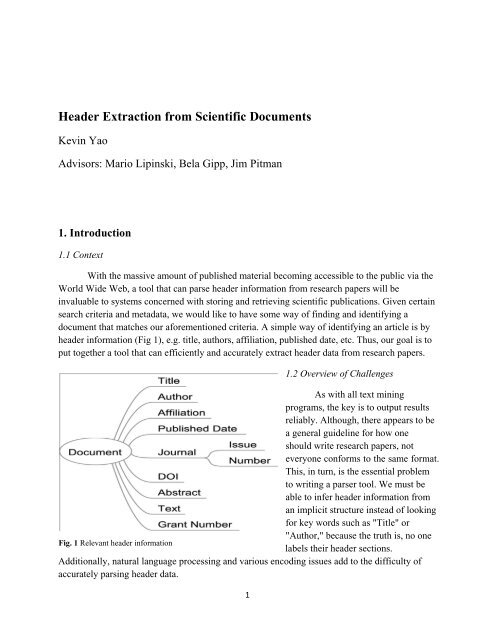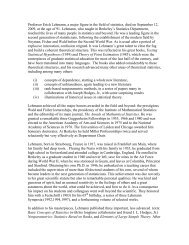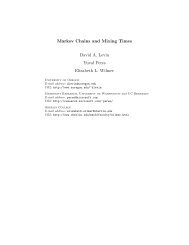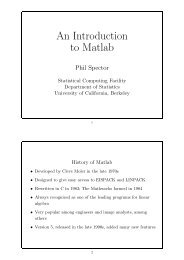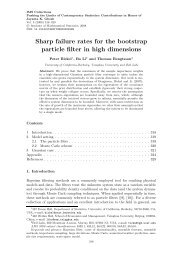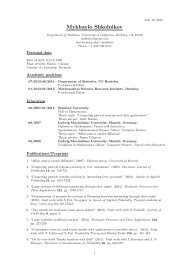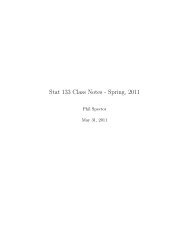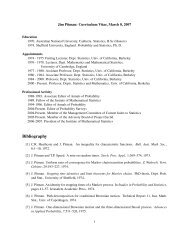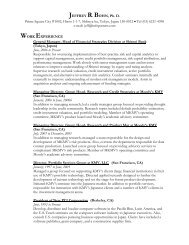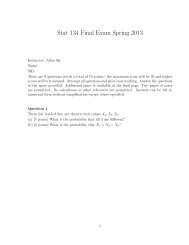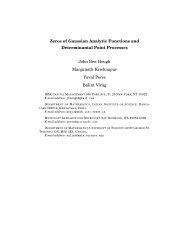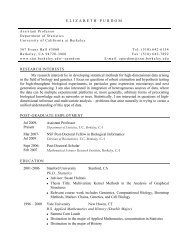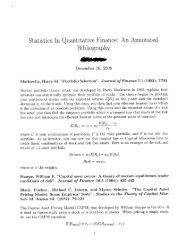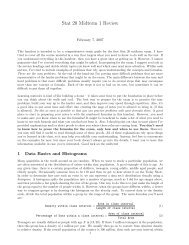Header Extraction from Scientific Documents
Header Extraction from Scientific Documents
Header Extraction from Scientific Documents
You also want an ePaper? Increase the reach of your titles
YUMPU automatically turns print PDFs into web optimized ePapers that Google loves.
<strong>Header</strong> <strong>Extraction</strong> <strong>from</strong> <strong>Scientific</strong> <strong>Documents</strong><br />
Kevin Yao<br />
Advisors: Mario Lipinski, Bela Gipp, Jim Pitman<br />
1. Introduction<br />
1.1 Context<br />
With the massive amount of published material becoming accessible to the public via the<br />
World Wide Web, a tool that can parse header information <strong>from</strong> research papers will be<br />
invaluable to systems concerned with storing and retrieving scientific publications. Given certain<br />
search criteria and metadata, we would like to have some way of finding and identifying a<br />
document that matches our aforementioned criteria. A simple way of identifying an article is by<br />
header information (Fig 1), e.g. title, authors, affiliation, published date, etc. Thus, our goal is to<br />
put together a tool that can efficiently and accurately extract header data <strong>from</strong> research papers.<br />
1<br />
1.2 Overview of Challenges<br />
As with all text mining<br />
programs, the key is to output results<br />
reliably. Although, there appears to be<br />
a general guideline for how one<br />
should write research papers, not<br />
everyone conforms to the same format.<br />
This, in turn, is the essential problem<br />
to writing a parser tool. We must be<br />
able to infer header information <strong>from</strong><br />
an implicit structure instead of looking<br />
for key words such as "Title" or<br />
"Author," because the truth is, no one<br />
Fig. 1 Relevant header information<br />
labels their header sections.<br />
Additionally, natural language processing and various encoding issues add to the difficulty of<br />
accurately parsing header data.
1.3 Our Plan<br />
To develop a tool that can parse header information not only accurately, but also<br />
efficiently, is a daunting task. Therefore, our plan is to survey the existing tools and then use<br />
these tools for our own implementation, building on top of and combining them if necessary.<br />
This report serves to highlight our current development and our outlook.<br />
2. Methods& Tools<br />
2.1 Overview of Concepts<br />
To be able to parse information <strong>from</strong> scientific documents, one must be familiar with<br />
certain concepts in use today. We know, <strong>from</strong> looking at the available tools that are engaged with<br />
header extraction, that there are three fundamental approaches. The most widely distributed<br />
format of research papers is the Adobe Portable Document Format (pdf). Hence, one possible<br />
approach to the problem of header extraction is to conduct pattern matching via regular<br />
expressions, font size and structural matching after converting the pdf file to an accessible format<br />
such as txt or xml. Another popular method is to use a knowledge base, such as an existing<br />
online service like Google Scholar, to act as a cross-reference to your document. For instance,<br />
one may extract small amount of information <strong>from</strong> the document and query Google Scholar to<br />
fill in the remainder of header contents needed. Lastly, the final approach is the use of machine<br />
learning techniques, which is a more practical approach compared to the first approach. Current<br />
implementations with machine learning techniques use support vector machines (SVM) [1],<br />
hidden Markov models (HMM) [2] and conditional random fields (CRF) [3] to extract data<br />
logically. Naturally, one might also be interested in combining all of these approaches and<br />
merging the results.<br />
2.2 Available Tools<br />
There are many groups working on data extraction <strong>from</strong> scientific documents, including<br />
many groups that are developing tools for citation extractions. However, for our purpose of<br />
header extraction, the number of existing tools is fairly limited. Through a near-exhaustive<br />
search on the web, we discovered a small number of tools, most of which are not fully developed.<br />
Furthermore, to use the tools implemented by other organizations, the best option for us would<br />
be to use open-source tools, only then will we have complete control and knowledge of the tools.<br />
These requirements narrowed our choices to just a handful - notably, half of which are new<br />
endeavors, suggesting that there is a growing interest and need in the area of header extraction.<br />
3. My Contribution<br />
3.1 Comparison of the Tools<br />
2
After researching and finding the parser tools online, I initially compiled a table of all<br />
the current available tools and examined their top-level behaviors - a simplified version (Fig 2) is<br />
available for viewing.<br />
Name of Approach Link Open-Source?<br />
Tool<br />
Mendeley SVM & web-based http://www.mendeley.com/<br />
No<br />
Desktop look-up<br />
pdfssa4met pdf2xml code.google.com/p/pdfssa4met Yes<br />
<strong>Header</strong>Parser SVM<br />
http://sourceforge.net/projects/citeseer Yes<br />
Service<br />
x/<br />
ParsCit CRF http://aye.comp.nus.edu.sg/parsCit/ Yes<br />
GROBID - CRF<br />
http://grobid.no-ip.org/<br />
Yes<br />
online<br />
http://sourceforge.net/projects/grobid<br />
pdfmeat Queries Google http://code.google.com/p/pdfmeat/ Yes<br />
Scholar, pdftotext<br />
Zotero Queries Google http://www.zotero.org/<br />
Yes<br />
Scholar<br />
Paperpile Web-based look-up http://paperpile.com/beta/ Yes<br />
Fig 2 Initial examination of existing tools along with their respective websites<br />
As one can see, these tools are split between using machine learning techniques and<br />
querying a knowledge base. After this initial examination and resource-gathering, the next step<br />
was to test how well these tools performed on real research papers by conducting an informal test<br />
and a side-by-side comparison of the results (an excerpt available for viewing in Fig 3).<br />
Name of Tool Paper 1 Paper 2 Paper 3<br />
Mendeley Desktop<br />
Title, Authors, Journal, Year,<br />
Pages, URL, DOI<br />
Title, Authors, Journal, Year,<br />
Issue, Pages, URL, DOI<br />
Title, Authors, Journal, Year,<br />
Volume, Pages, Abstract,<br />
Keywords, URL, PMID<br />
pdfssa4met Title,Authors FAILED Title<br />
ParsCit<br />
Title, Authors, Affiliation, Email,<br />
Abstract<br />
Title, Authors, Affiliation,<br />
Address, Email, Abstract<br />
Title, Authors, Address, Email,<br />
Abstract,<br />
<strong>Header</strong>ParserService<br />
GROBID - online<br />
pdfmeat<br />
Title, Authors, Affiliation,<br />
Address, Email, Abstract<br />
Title, Authors, Department,<br />
Institution, Address, Email,<br />
Abstract<br />
Title, Authors, Year, Publisher,<br />
URL, Abstract<br />
Title, Authors, Affiliation,<br />
Address, Email, Abstract<br />
Abstract<br />
Title, Authors, ISSN, Year,<br />
Publisher, URL, Abstract<br />
Zotero Title, Authors, Date Title, Authors, Date, Pages<br />
Paperpile<br />
Title, Authors, Abstract, Journal,<br />
Year<br />
Title, Authors, Abstract, Journal,<br />
Pages, DOI, ISSN<br />
Title, Authors,Affiliation,<br />
Address, Email, Abstract<br />
Title, Authors, Department,<br />
Institution, Address, Abstract<br />
Title, Authors, Journal, Year,<br />
Volume, Number, Pages, ISSN,<br />
Publisher, Abstract, URL<br />
Title, Authors, Publication,<br />
Volume, Issue, Pages, Date,<br />
ISSN<br />
Title, Authors, Journal,<br />
Abstract, Volume, Pages, Year,<br />
Month, ISSN, Pubmed ID<br />
Fig 3 Performance of parser tools (showing three out of ten papers tested), green = correct, red = incorrect<br />
3
The test was informal in the sense that the papers used were hand-picked (not entirely<br />
random) specifically due to their different styles. However, there is really no categorization for<br />
different styles of research papers, so the procedure as to how one might formally test the<br />
performance of tools is a difficult task. Fortunately, the purpose of this test is to get a general<br />
grasp of how these tools are different and to see if a hybrid approach of integrating these tools is<br />
a viable option. As one can see <strong>from</strong> Figure 3, we will definitely be able to benefit <strong>from</strong><br />
integration of the tools because there is not a single tool that is perfect, so it will be to our<br />
advantage if we were to use multiple tools to fill in one another's deficiencies.<br />
3.2 Integration of the Tools<br />
Integration will not be a trivial task because the tools are all written in different languages<br />
and not all the tools can be run <strong>from</strong> the command line. Furthermore, we have no algorithm for<br />
merging the results of different tools. Thus, all we have done so far for this project is the<br />
designing of our future parser tool and the creation of the framework in Java. For this initial<br />
endeavor, we included four tools: pdfssa4met, ParsCit, <strong>Header</strong>ParserTool, and pdfmeat. These<br />
four were chosen because they can be executed <strong>from</strong> the command line, which greatly eases our<br />
implementation of the Java program. The framework provides us with a way to call all the<br />
different tools it knows and for each of these tools, generate a uniformly formatted result set.<br />
This result set is implemented with a Java class that contains instance variables for each of our<br />
header entities: title, author, affiliation, published date, journal title, journal issue, journal<br />
number, doi, and the abstract. If an entity can have multiple entries, such as when a document<br />
has multiple authors, that instance variable will be implemented using a Java HashSet. Hence,<br />
with this setup for the result set, we will be able to access, retrieve, store and compare data using<br />
a much more systematic manner than if we had to deal with all the different raw output formats<br />
created by the different tools. This gives us the clear advantage of not needing to worry about<br />
each tool’s individual implementations and let us focus on just the data outputted. Furthermore,<br />
to ensure that we do not lose all the auxiliary information when creating a result set <strong>from</strong> raw<br />
output, the result set will contain a HashMap that can store any other information we wish to<br />
extract <strong>from</strong> the raw output. One more advantage that arises is that a uniform result set allows us<br />
to merge outputs of different tools, so that we may benefit <strong>from</strong> filling in gaps using multiple<br />
tools. However, that is not to say that integrating result sets will be a trivial task, for there are<br />
many small nuisances one must consider in deciding which tool generated the “correct” data.<br />
4. Conclusion<br />
As this project is very early in its development, there are still many tasks we must<br />
accomplish before we have a precise and efficient header parser. Mainly, we must find ways to<br />
generate results <strong>from</strong> all the other relevant parser tools and figure out the best way to merge<br />
result sets. We hope that along with our current development, the tools that we are using will<br />
also improve, so that we will be able to push our precision closer and closer to 100 percent.<br />
4
5. Acknowledgments<br />
I would like to thank my advisors for giving me this opportunity to work on a part of their<br />
project and for aiding me with the resources necessary to accomplish my tasks. Also, I would<br />
like to acknowledge the effort put into the open source tools we have used for this project.<br />
Without the current development in header extraction, this project would not have been possible.<br />
6. References<br />
[1] Hui Han, C. Lee Giles, Eren Manavoglu, Hongyuan Zha, Zhenyue Zhang, and Edward A. Fox. 2003.<br />
Automatic document metadata extraction using support vector machines. In Proceedings of the 3rd<br />
ACM/IEEE-CS joint conference on Digital libraries (JCDL '03). IEEE Computer Society, Washington,<br />
DC, USA, 37-48.<br />
[2] Erik Hetzner. 2008. A simple method for citation metadata extraction using hidden markov models.<br />
In Proceedings of the 8th ACM/IEEE-CS joint conference on Digital libraries (JCDL '08). ACM, New<br />
York, NY, USA, 280-284. DOI=10.1145/1378889.1378937 http://doi.acm.org/10.1145/1378889.1378937<br />
[3] Fuchun Peng and Andrew McCallum. 2006. Information extraction <strong>from</strong> research papers using<br />
conditional random fields. Inf. Process. Manage. 42, 4 (July 2006), 963-979.<br />
DOI=10.1016/j.ipm.2005.09.002 http://dx.doi.org/10.1016/j.ipm.2005.09.002<br />
5


